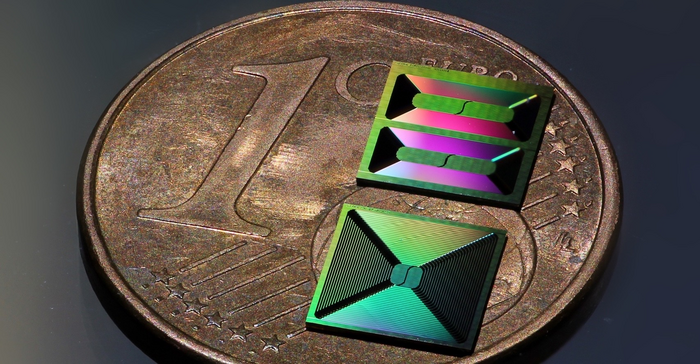Perhaps one of the most significant technological advancements underpinning society is the possibility to accomplish quantum-limited amplification of optical signals enclosed in optical fibers.

The photonic integrated circuits used in this study. Image Credit: Tobias Kippenberg (EPFL)
The choice of the 1550 nm wavelength band for optical telecommunications is driven not only by the loss minima of silica optical fibers (a development recognized with the 2008 Nobel Prize in Physics) but also by the availability of methods to amplify these signals, which is essential to achieving trans-oceanic fiber optical communication.
Virtually all laser-based technologies depend on optical amplification, from optical communication—used, for example, in data centers to connect servers across continents—to ranging applications like coherent Frequency Modulated Continuous Wave (FMCW) LiDAR, an emerging technology that can detect and track objects more accurately and quickly than ever before.
Today, optical amplifiers based on III-V semiconductors and rare-earth ions like erbium are frequently used in practical applications.
These two methods rely on optical transition-based amplification. However, traveling-wave parametric amplifiers, which increase the signal by varying a small system “parameter” like the capacitance or the nonlinearity of a transmission line, represent a different paradigm of optical signal amplification.
Optical Parametric Amplifiers
Since the 1980s, it has been known that the inherent nonlinearity of optical fibers can also be used to build traveling-wave optical parametric amplifiers. These amplifiers can be broad-band and practically cover any wavelength since their gain is independent of atomic or semiconductor transitions.
Since parametric amplifiers do not have a minimum input signal requirement, they can be used to amplify both weak signals and strong input power simultaneously.
Last but not least, waveguide geometry optimization and dispersion engineering allow for the gain spectrum to be customized, providing tremendous design flexibility for various applications and wavelength targets.
The most fascinating aspect is that parametric gain can be obtained in peculiar wavelength bands that are inaccessible to common semiconductors or rare-earth-doped fibers. Inherently quantum-limited, parametric amplification can even produce noiseless amplification.
Silicon Limitations
Despite having appealing characteristics, optical parametric amplifiers in fibers are hindered by the extremely high pump power requirements brought on by the silica’s weak Kerr nonlinearity.
Continuous-wave-operated amplifiers have not been made possible by the advancements in integrated photonic platforms over the past 20 years, but they have significantly improved effective Kerr nonlinearity, which is not possible in silica fibers.
Operating in the continuous-wave regime is not a mere ‘academic achievement’. In fact, it is crucial to the practical operation of any amplifier, as it implies that any input signals can be amplified—for example, optically encoded information, signals from LiDAR, sensors, etc. Time- and spectrum-continuous, traveling-wave amplification is pivotal for successful implementation of amplifier technologies in modern optical communication systems and emerging applications for optical sensing and ranging.
Tobias Kippenberg, Professor and Head, Laboratory of Photonics and Quantum Measurements, École polytechnique fédérale de Lausanne
Breakthrough Photonic Chip
The issue has now been resolved in a new study in Kippenberg’s lab under the direction of Dr. Johann Riemensberger by creating a traveling-wave amplifier based on a photonic integrated circuit operating in the continuous regime.
Our results are a culmination of more than a decade of research effort in integrated nonlinear photonics and the pursuit of ever lower waveguide losses.
Dr. Johann Riemensberger, Scientist, Laboratory of Photonics and Quantum Measurements, École polytechnique fédérale de Lausanne
On a photonic chip measuring 3×5 mm2, the researchers created the first traveling-wave amplifier using an ultralow-loss silicon nitride photonic integrated circuit that was more than 2 m long. The chip operates in a continuous regime and offers 2 dB net gain over fiber-to-fiber in the telecommunication bands and 7 dB net gain on-chip.
The Chalmers University groups of Victor Torres-Company and Peter Andrekson have also recently succeeded in on-chip net-gain parametric amplification in silicon nitride.
The team will be able to utilize precise lithographic control in the future to enhance waveguide dispersion for parametric gain bandwidth higher than 200 nm.
Furthermore, since silicon nitride has a very low fundamental absorption loss (about 0.15 dB/meter), further fabrication optimizations can increase the chip’s maximum parametric gain above 70 dB with only 750 mW of pump power, outperforming the performance of the best fiber-based amplifiers.
Kippenberg added, “The application areas of such amplifiers are unlimited. From optical communications where one could extend signals beyond the typical telecommunication bands, to mid-infrared or visible laser and signal amplification, to LiDAR or other applications where lasers are used to probe, sense and interrogate classical or quantum signals.”
Journal Reference
Riemensberger, J., et al. (2022) A photonic integrated continuous-travelling-wave parametric amplifier. Nature. doi:10.1038/s41586-022-05329-1.